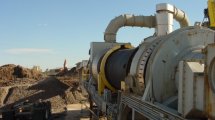Our Clients
- US Army Corps of Engineers (Superfund Project)
- King of Prussia Technical Corporation Site PRP Group (Superfund Project)
- Springfield Township Site PRP Group (Superfund Project)
- US Naval Facilities Engineering
- United States Department of Energy
- Westinghouse Hanford Company
- DuPont
- Daimler-Chrysler
- ARCADIS
- Eco Recycling Systems (France)
- City of Montreal (Canada)
- HERA AG Ambiental (Spain)
- BEFESA Gestion de Residuos Industriales (Spain)
- The Monsanto Company
- Honeywell International
- Parsons Engineering Science, Inc.
- RMI Environmental Services
- ELM Group
- Hoffman La Roche
- Langan Engineering
- Troy Chemical Company
- Penbrook Homes / Abito
Thermal Desorption
ART and its associates can provide Low Temperature Thermal Desorption (LTTD) or High Temperature Thermal Desorption (HTTD) thermal desorption plants. A wide range of indirect and direct heated mobile and stationary systems is available. Treatment capacity ranges from 2 tph to 50 tph. Each plant is backed up with production rate and performance guarantees which are the best available in the business. Laboratory process testing is available.
 Thermal
desorption is a physical separation process. Contaminated soil or wastes are
heated in a
rotary dryer (kiln) to volatilize water and organic contaminants. A carrier gas
transports volatilized water and organics to the gas treatment system. The
offgas is then treated to recover or destroy the contaminants. Two basic types
of thermal desorption systems are available: Direct Fired and
Indirect Fired.
Thermal
desorption is a physical separation process. Contaminated soil or wastes are
heated in a
rotary dryer (kiln) to volatilize water and organic contaminants. A carrier gas
transports volatilized water and organics to the gas treatment system. The
offgas is then treated to recover or destroy the contaminants. Two basic types
of thermal desorption systems are available: Direct Fired and
Indirect Fired.
Direct Fired: Direct fired thermal desorption systems have been used extensively over the years for petroleum contaminated soils and waste treatment. The contaminants transfer into the offgas which is directed to a thermal oxidizer for final destruction of the volatilized organics. Direct fired thermal desorption systems can also be used for treatment of soils and wastes contaminated with RCRA hazardous wastes including chlorinated solvents, pesticides and PCB's. When treating chlorinated compounds, the addition of a quench and scrubber after the oxidizer is typically required. Typical solids temperature is around 750 to 900 °F depending on the material of construction of the cylinder. Total residence time ranges from 3 to 15 minutes. Contaminants are destroyed in an oxidizer. Particulates are removed from the air stream by conventional particulate removal equipment, such as wet scrubbers and a baghouse.
Indirect Fired: An indirect fired thermal desorption system consists of a double wall inclined rotary dryer (kiln). The heat transfer mechanism is via conduction through the cylinder wall. In this type of system neither the flame nor the products of combustion can contact the feed solids or the offgas. Think of it as a rotating pipe inside a furnace with both ends sticking outside of the furnace. With a carbon steel shell, the maximum solids temperature is around 1,000 °F; with special alloy cylinders temperatures of 1,800 °F are attainable. Total residence time in this type of desorber normally ranges from 30 to 120 minutes. Contaminants can be either condensed from the gas stream and/or destroyed in an thermal oxidizer. Particulates are removed from the air stream by conventional particulate removal equipment, such as wet scrubbers and a baghouse.
Based on the operating temperature of the desorber, thermal desorption processes can be categorized into two groups: Low Temperature Thermal Desorption (LTTD) and High Temperature Thermal Desorption (HTTD)
Low Temperature Thermal Desorption (LTTD)
In LTTD, wastes are heated to between 90 and 320 °C (200 to 600 °F). LTTD is a full-scale technology that has been proven successful for remediating petroleum hydrocarbon contamination in all types of soil. The target contaminant groups for LTTD systems are nonhalogenated VOCs and fuels. The technology can be used to treat Semi Volatile Organic Compound (SVOCs) at reduced effectiveness. Decontaminated soil retains its physical properties. Unless being heated to the higher end of the LTTD temperature range, organic components in the soil are not damaged, which enables treated soil to retain the ability to support future biological activity.
High Temperature Thermal Desorption (HTTD)
HTTD is a full-scale technology in which wastes are heated to 320 to 560 °C (600 to 1,000 °F). HTTD is frequently used in combination with incineration, solidification/stabilization, or dechlorination, depending upon site-specific conditions. The technology has proven it can produce a final contaminant concentration level below 5 mg/kg for the target contaminants identified. The target contaminants for HTTD are SVOCs, PAHs, PCBs, and pesticides (DDT); however, VOCs and fuels also may be treated, but treatment may be less cost-effective. Volatile metals may be removed by HTTD systems. The presence of chlorine can affect the volatilization of some metals, such as lead. The process is applicable for the separation of organics from refinery wastes, coal tar wastes, wood-treating wastes, creosote-contaminated soils, hydrocarbon-contaminated soils, mixed (radioactive and hazardous) wastes, synthetic rubber processing waste, pesticides and paint wastes.
